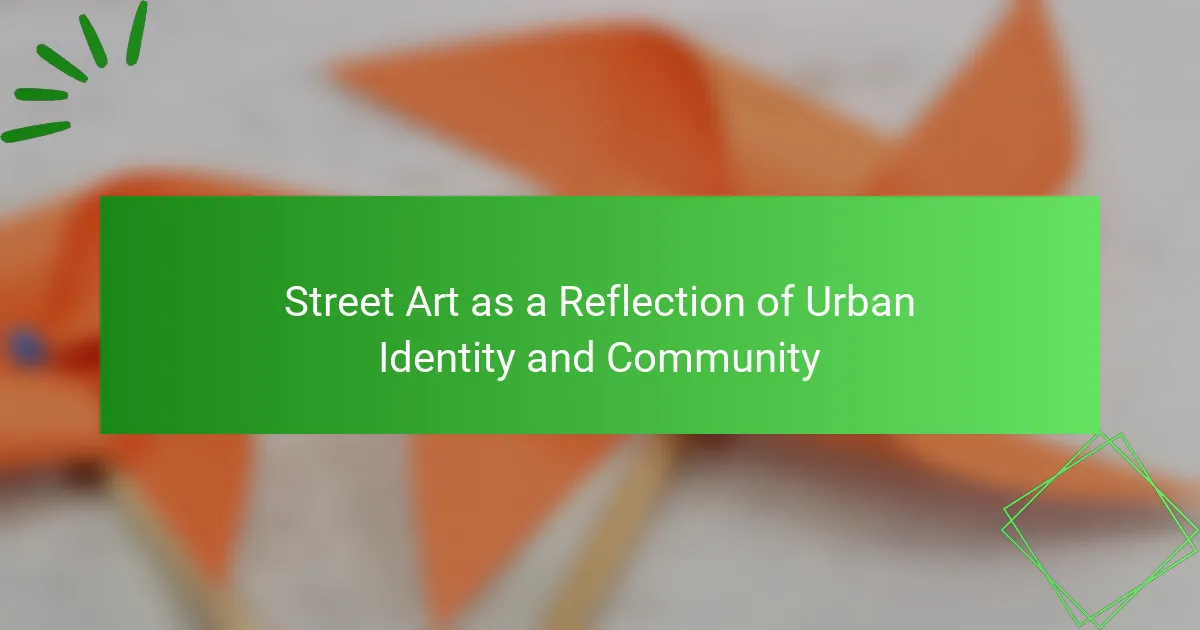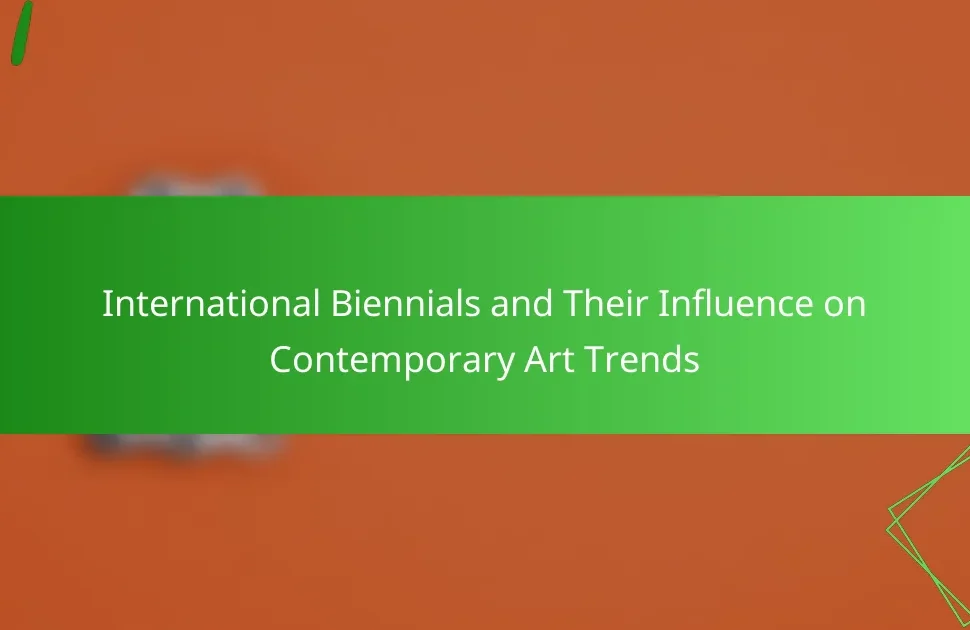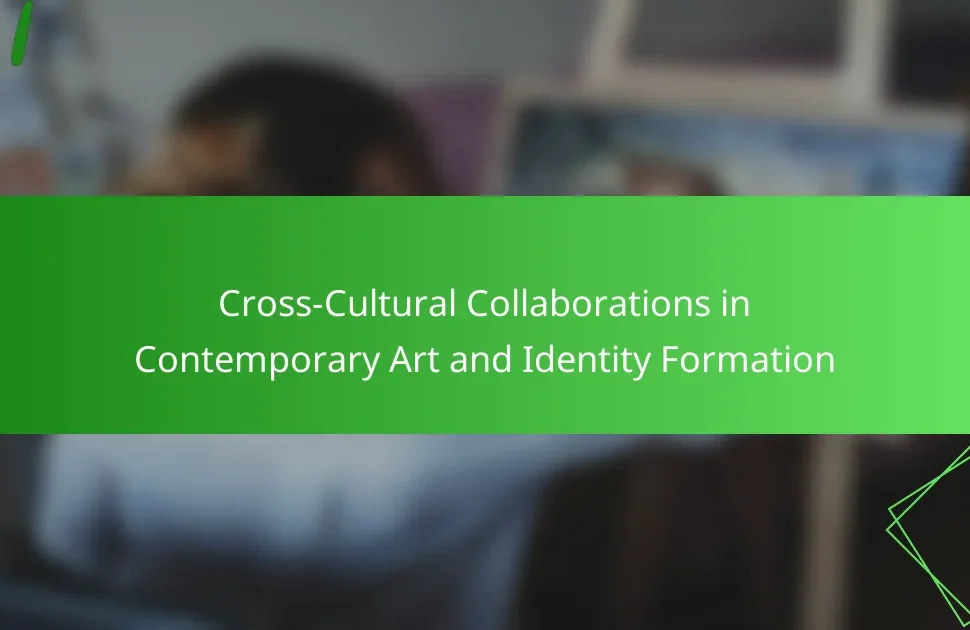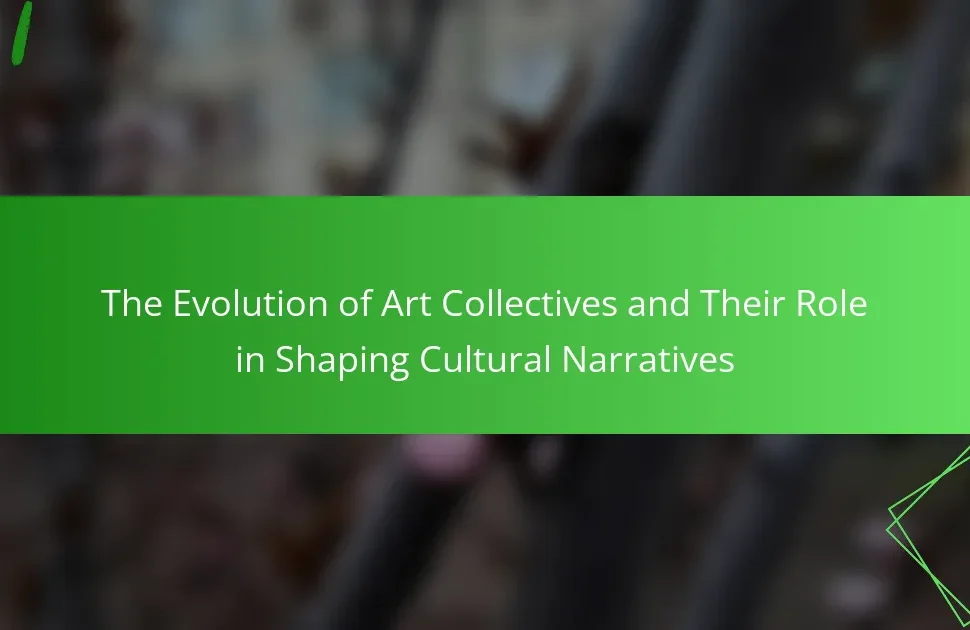Street art plays a vital role in shaping urban identity and community by reflecting local values and narratives. It transforms public spaces, fosters engagement, and promotes dialogue on social issues. This art form bridges cultural gaps, enhances local pride, and stimulates economic growth. By addressing contemporary themes and incorporating diverse styles, street art becomes a powerful medium for self-expression and community cohesion.
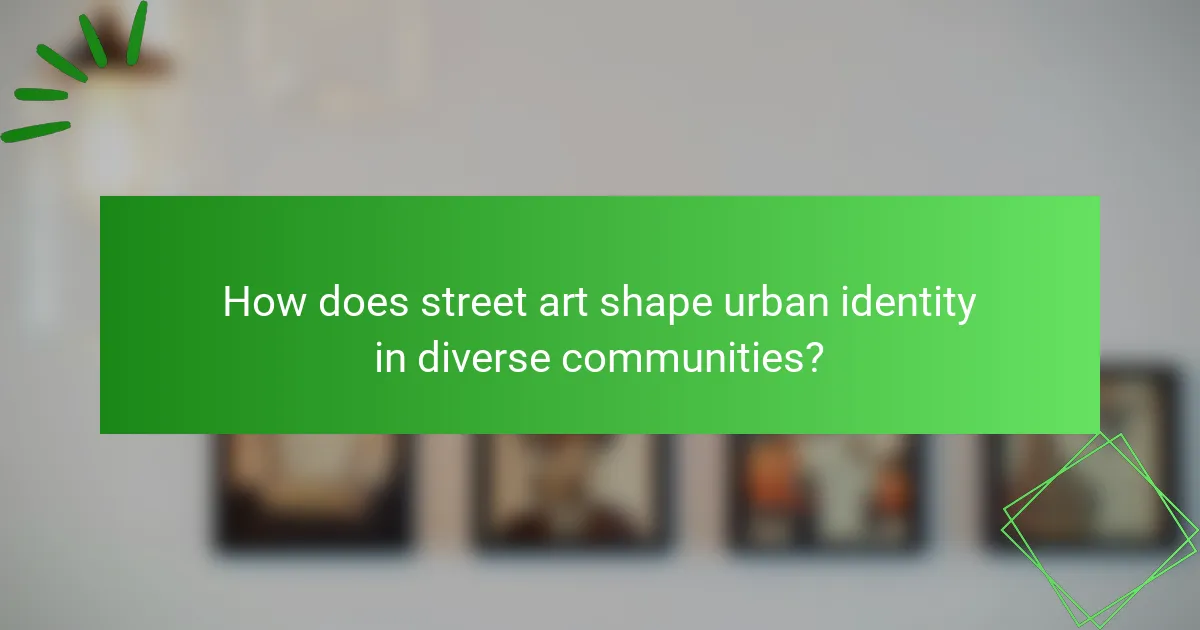
How does street art shape urban identity in diverse communities?
Street art significantly shapes urban identity by reflecting community values and narratives. It serves as a visual representation of cultural diversity and social issues within neighborhoods. This art form fosters a sense of belonging and pride among residents, as it often incorporates local history and traditions.
Moreover, street art can transform public spaces, making them more vibrant and engaging. It attracts tourism and stimulates local economies, enhancing the overall urban experience. By giving voice to marginalized communities, street art challenges societal norms and promotes dialogue on important issues.
In diverse communities, street art acts as a unifying force, bridging gaps between different cultural backgrounds. It encourages collaboration among artists and residents, fostering a shared identity and collective memory. As a result, street art plays a crucial role in defining the character and essence of urban environments.
What role does cultural context play in street art interpretation?
Cultural context significantly influences how street art is interpreted, shaping meanings and perceptions. Local history, social issues, and community identity are reflected in the artwork, creating unique narratives. For instance, a mural addressing gentrification in an urban area resonates differently for residents compared to outsiders. Additionally, cultural symbols and references embedded in street art can vary widely, impacting interpretation based on the viewer’s background. As a result, understanding the cultural context enhances appreciation and comprehension of street art as a vital expression of urban identity.
How do local artists reflect their communities through their work?
Local artists reflect their communities through street art by expressing cultural identity, social issues, and shared experiences. This art form transforms urban spaces into canvases that celebrate local heritage and foster community pride. Street art often addresses relevant topics such as inequality, environmental concerns, and local history, creating a dialogue between the artist and the audience. For example, murals depicting historical events or notable figures resonate with residents, reinforcing a sense of belonging. Additionally, street art can serve as a catalyst for community engagement, inviting collaboration and conversation among diverse groups.
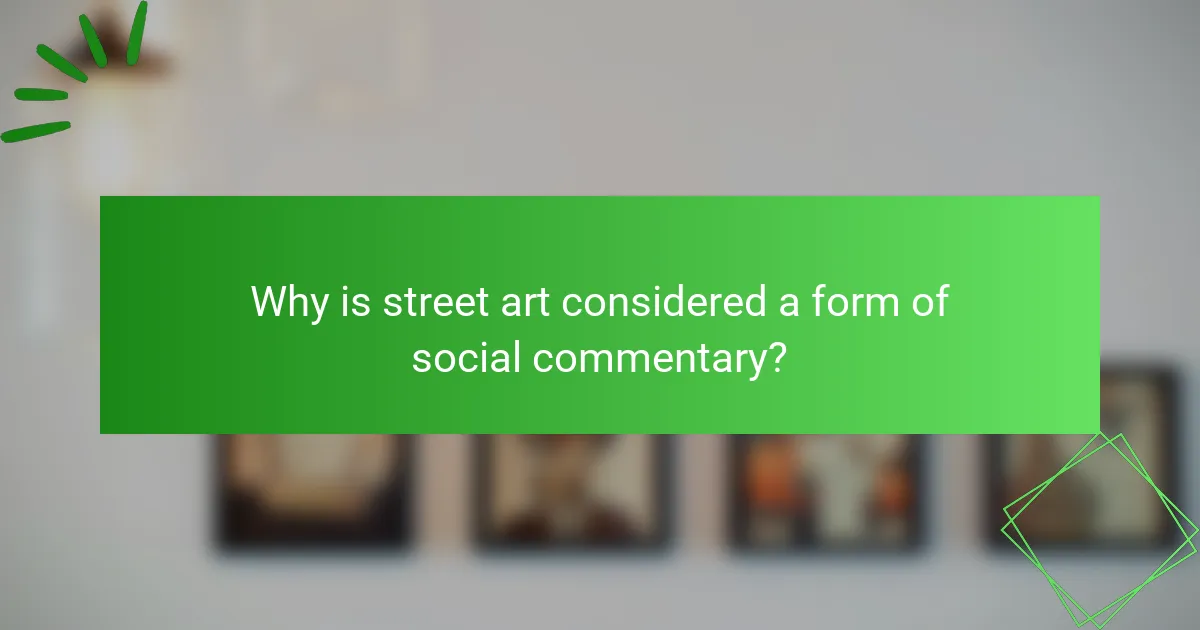
Why is street art considered a form of social commentary?
Street art is considered a form of social commentary because it reflects community issues and urban identity. Artists often address social injustices, political themes, and cultural narratives through their work. This art form serves as a voice for marginalized communities, making statements that provoke thought and dialogue. For example, murals can highlight local histories or current events, engaging viewers emotionally and intellectually. Street art transforms public spaces into platforms for expression, fostering a sense of belonging and awareness.
In what ways does street art address social issues and injustices?
Street art addresses social issues and injustices by raising awareness, fostering dialogue, and empowering communities. It serves as a visual platform for marginalized voices, often challenging societal norms and highlighting inequalities. For example, murals can depict local struggles, such as poverty or systemic racism, prompting viewers to engage with these topics. As a result, street art becomes a catalyst for social change, encouraging community involvement and activism. Through creative expression, artists convey powerful messages that resonate with urban identity and collective experience.
How do different regions express their unique challenges through street art?
Different regions express unique challenges through street art by reflecting local issues, cultural identities, and social movements. Street art serves as a powerful medium for community voices, addressing topics like poverty, political unrest, and environmental concerns. For instance, murals in urban areas often highlight gentrification, while graffiti in marginalized neighborhoods may depict resilience against systemic oppression. The choice of imagery, colors, and styles varies significantly, showcasing local narratives and histories. This art form not only beautifies spaces but also fosters dialogue and awareness around pressing regional challenges.
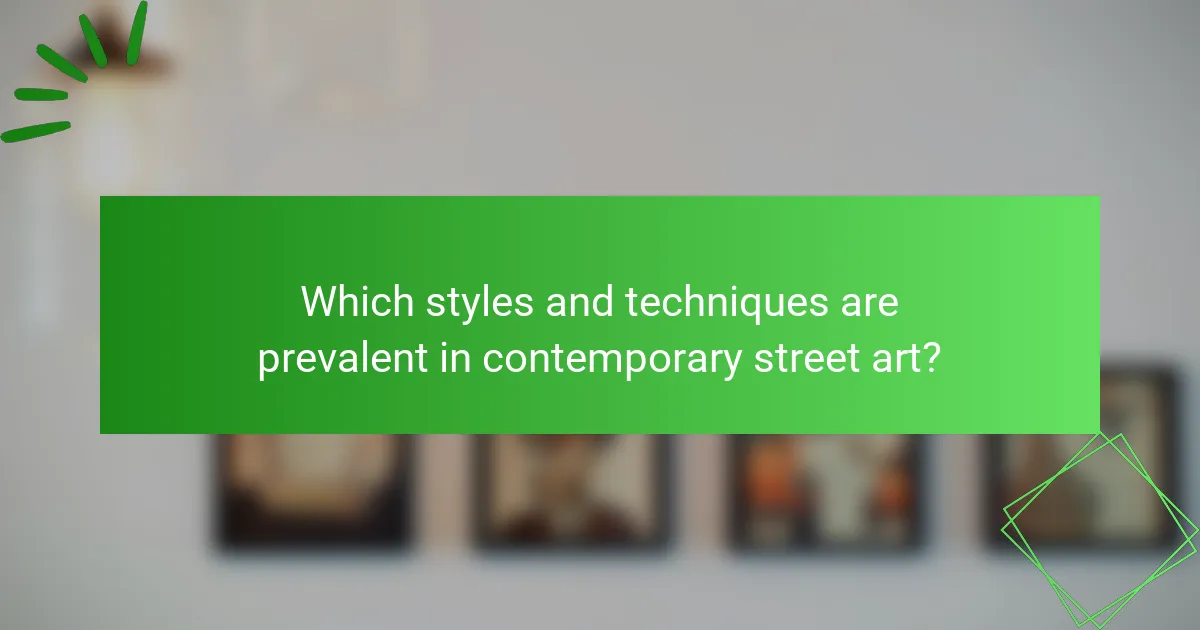
Which styles and techniques are prevalent in contemporary street art?
Contemporary street art features diverse styles and techniques that reflect urban identity and community. Prominent styles include graffiti, stencils, murals, and paste-ups, each offering unique expressions of local culture. Techniques such as spray painting, wheatpasting, and digital projections enhance visibility and engagement. Artists often incorporate social and political themes, fostering dialogue within communities. The use of vibrant colors and intricate designs creates a visual impact that resonates with urban dwellers, making street art a dynamic element of city life.
What are the most popular forms of street art across various cultures?
Street art varies widely across cultures, showcasing diverse forms such as murals, graffiti, and stencil art. Murals often reflect community narratives and local history, while graffiti serves as a medium for personal expression and social commentary. Stencil art, popularized by artists like Banksy, combines simplicity with powerful messages. In Japan, ukiyo-e influenced street art, blending traditional aesthetics with contemporary themes. In Latin America, vibrant colors and political messages dominate, highlighting social issues. Each form enhances urban identity and fosters community engagement.
How do techniques differ between urban environments?
Techniques in urban street art vary based on cultural context, community engagement, and environmental factors. Urban environments influence artistic styles, themes, and methods of expression. For instance, murals may reflect local history or social issues, while graffiti often serves as a form of protest or identity assertion. Community involvement shapes the narrative, with collaborative projects fostering a sense of belonging. Additionally, the physical characteristics of urban spaces, such as wall texture and visibility, dictate artistic choices.

What impact does street art have on community engagement?
Street art significantly enhances community engagement by fostering local identity and encouraging dialogue among residents. It transforms public spaces into platforms for self-expression and cultural representation.
Street art often reflects community values and issues, creating a sense of belonging. For instance, murals can address social justice, environmental awareness, or historical narratives pertinent to the area. This connection to local identity promotes pride among residents, encouraging them to participate in community events and initiatives.
Furthermore, street art invites interaction from diverse groups, bridging gaps between different demographics. It serves as a catalyst for discussions and collaborations, uniting individuals with varying perspectives around shared experiences and aspirations.
As a result, street art not only beautifies urban environments but also strengthens social ties, making communities more cohesive and engaged.
How does street art foster dialogue among residents?
Street art fosters dialogue among residents by reflecting community values and encouraging interaction. It serves as a visual language that expresses local identity, addressing social issues and personal stories. This artistic medium invites conversations, promotes inclusivity, and strengthens community bonds. As a result, residents engage more actively with their surroundings, creating a sense of belonging.
What initiatives promote collaboration between artists and communities?
Initiatives that promote collaboration between artists and communities include public art projects, community workshops, and mural festivals. These initiatives engage local residents and artists, fostering creativity and a sense of ownership. Public art projects often reflect community identity, while workshops provide platforms for skill sharing. Mural festivals can transform neighborhoods, attracting visitors and enhancing local pride. These collaborative efforts strengthen community ties and celebrate cultural diversity.
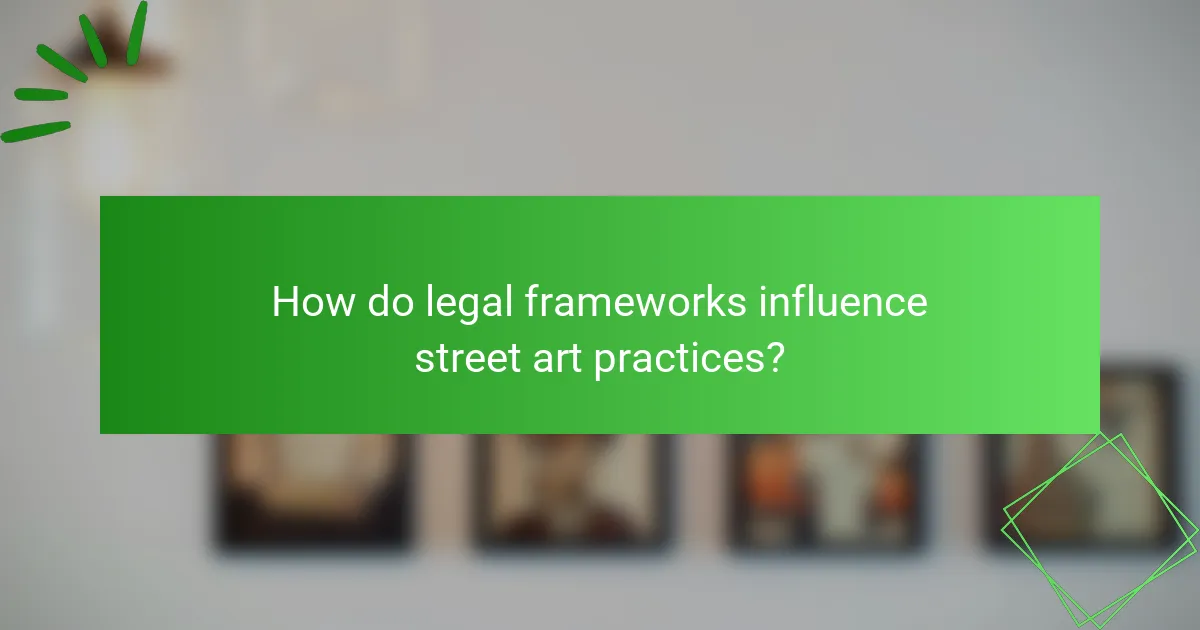
How do legal frameworks influence street art practices?
Legal frameworks significantly shape street art practices by establishing boundaries for expression. Regulations can either support or restrict artistic freedom, influencing the visibility and acceptance of street art within communities. For instance, cities with supportive policies often see vibrant street art scenes that reflect urban identity, while restrictive laws may drive artists underground. Additionally, legal recognition of street art can enhance community engagement and foster local pride, showcasing unique cultural narratives.
What are the challenges of navigating legality in street art creation?
Navigating legality in street art creation presents significant challenges due to varying laws and regulations. Artists face issues like property rights, local ordinances, and potential criminal charges. The enforcement of these laws can differ widely between cities, impacting artists’ ability to express urban identity. Additionally, public perception of street art can influence legal outcomes, with some communities embracing it while others view it as vandalism. Understanding these dynamics is crucial for artists seeking to engage with their communities legally and meaningfully.
How do different countries approach street art regulations?
Different countries adopt varied approaches to street art regulations, balancing creative expression and public order. In some nations, street art is embraced and supported, while in others, it faces strict limitations.
For instance, in Germany, cities like Berlin promote street art through legal walls and festivals, recognizing its cultural significance. Conversely, in Singapore, strict laws prohibit unauthorized graffiti, reflecting a more conservative stance on public space usage.
The United States showcases a mix of attitudes; cities like New York celebrate street art as part of their identity, while others enforce stringent anti-graffiti laws. This diversity illustrates how urban identity influences the acceptance and regulation of street art globally.
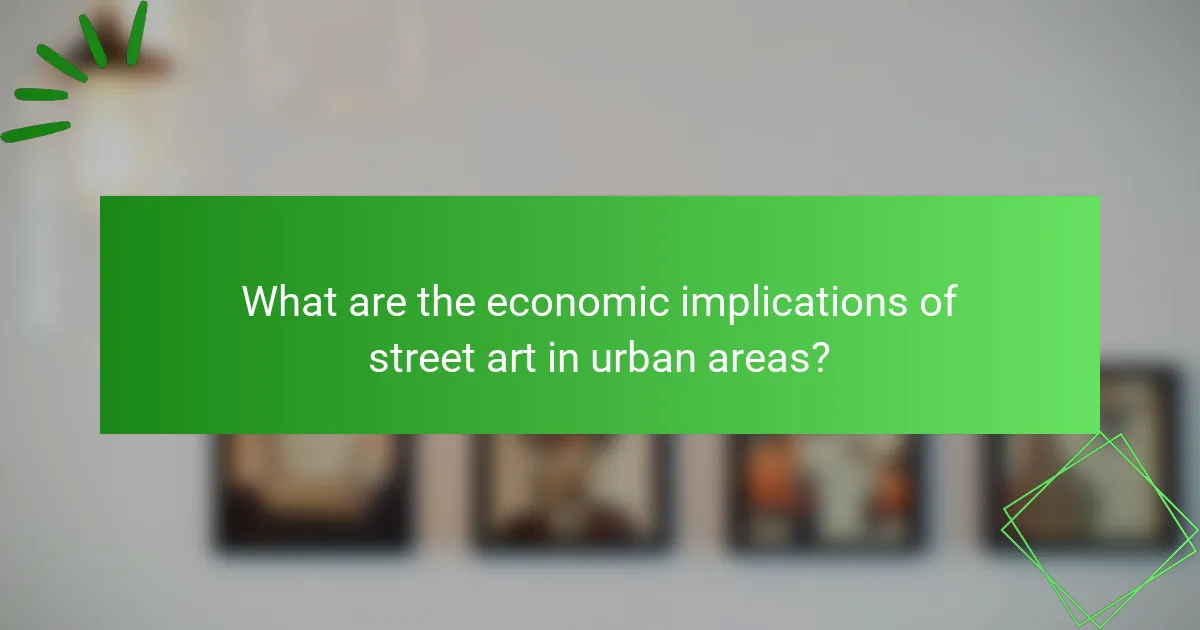
What are the economic implications of street art in urban areas?
Street art significantly impacts urban economies by enhancing community identity and attracting tourism. It fosters local businesses, increases property values, and promotes cultural engagement. For instance, cities with vibrant street art scenes often see a boost in foot traffic, which benefits nearby shops and restaurants. Moreover, street art can serve as a catalyst for urban renewal, transforming neglected areas into attractive destinations. As a result, cities invest in street art initiatives, recognizing its potential to drive economic growth and community pride.
How does street art contribute to local tourism and economy?
Street art significantly boosts local tourism and the economy by attracting visitors and fostering community engagement. It enhances urban identity, creating unique cultural experiences that draw tourists. Cities with vibrant street art scenes report increased foot traffic, benefiting local businesses. For instance, areas known for street art often see a rise in sales for nearby cafes, shops, and galleries. Additionally, street art festivals can generate substantial revenue through tourism-related activities, showcasing local talent while promoting cultural heritage.
What are the financial challenges faced by street artists?
Street artists face significant financial challenges, including lack of funding, inconsistent income, and limited access to resources. Many street artists rely on public spaces, which can lead to legal issues and fines. Additionally, competition for visibility and recognition can further strain their financial stability. The transient nature of street art often means that artists do not receive ongoing financial support for their work.
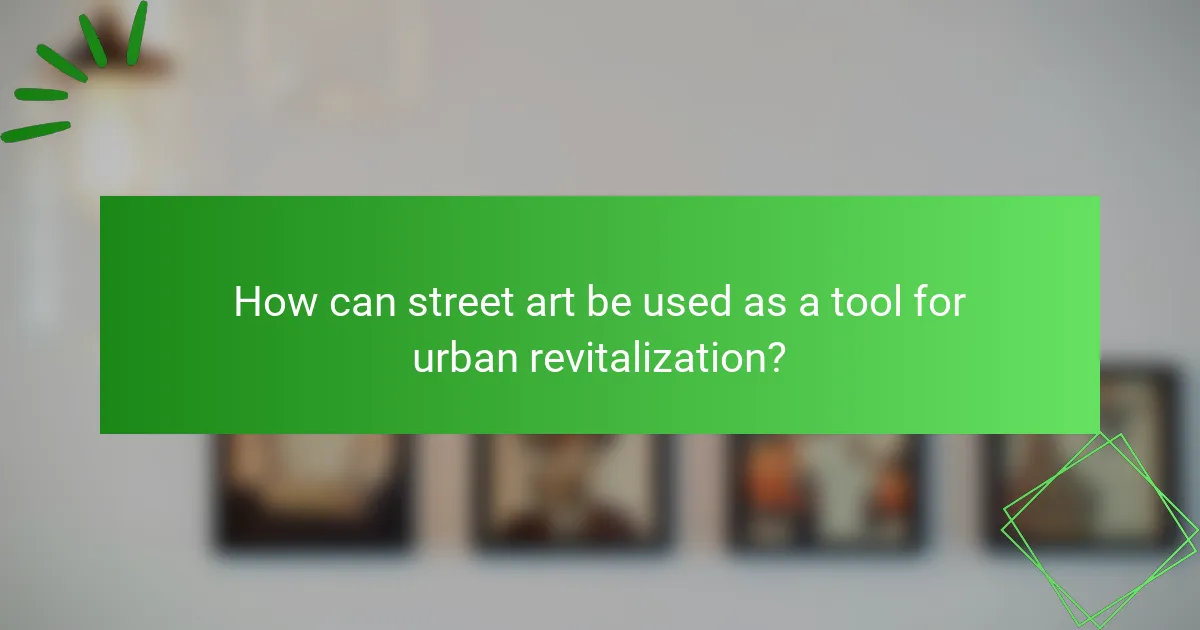
How can street art be used as a tool for urban revitalization?
Street art can effectively revitalize urban areas by enhancing community identity and engagement. It transforms neglected spaces into vibrant cultural hubs, fostering local pride and attracting visitors. This artistic expression often reflects the unique stories and values of the community, creating a sense of belonging. Moreover, studies have shown that areas enriched with street art experience increased foot traffic and economic activity.
What successful case studies exist of street art-led regeneration?
Successful case studies of street art-led regeneration illustrate its impact on urban identity and community cohesion. Cities like Berlin, Bristol, and Melbourne have transformed neglected areas into vibrant cultural hubs through street art initiatives.
In Berlin, the East Side Gallery showcases murals that reflect historical narratives and local identity. This open-air gallery has become a symbol of unity and resilience post-reunification.
Bristol’s Upfest festival promotes local artists and engages the community, revitalizing public spaces while fostering a sense of pride. The festival has increased tourism and local business revenue significantly.
Melbourne’s laneways are famous for their dynamic street art scene, attracting visitors and enhancing the urban landscape. This initiative has led to increased foot traffic and economic growth in surrounding areas.
These examples demonstrate how street art can serve as a catalyst for regeneration, enhancing cultural identity and community engagement.
How do cities balance preservation and new street art projects?
Cities balance preservation and new street art projects by fostering dialogue between artists, communities, and local governments. This collaboration ensures that new artworks reflect urban identity while respecting historical contexts.
Preservation of existing murals and heritage sites provides a backdrop for new expressions of creativity. For instance, integrating street art into revitalization efforts can enhance community engagement and tourism.
Moreover, policies can be established to protect significant works while promoting new projects. This approach encourages diverse artistic voices, contributing to a vibrant urban landscape.
Ultimately, the balance between preservation and innovation cultivates a dynamic cultural identity, showcasing the evolving narrative of the community.
What best practices can communities adopt to support street art?
Communities can adopt best practices to support street art by fostering collaboration, providing legal spaces, and promoting local artists. Engaging with artists during planning stages ensures that the art reflects community identity. Legal walls and designated areas reduce vandalism and encourage creativity. Organizing events and workshops can enhance appreciation and understanding of street art as a cultural asset. Furthermore, involving local businesses in funding or promoting projects strengthens community ties and supports the local economy.
